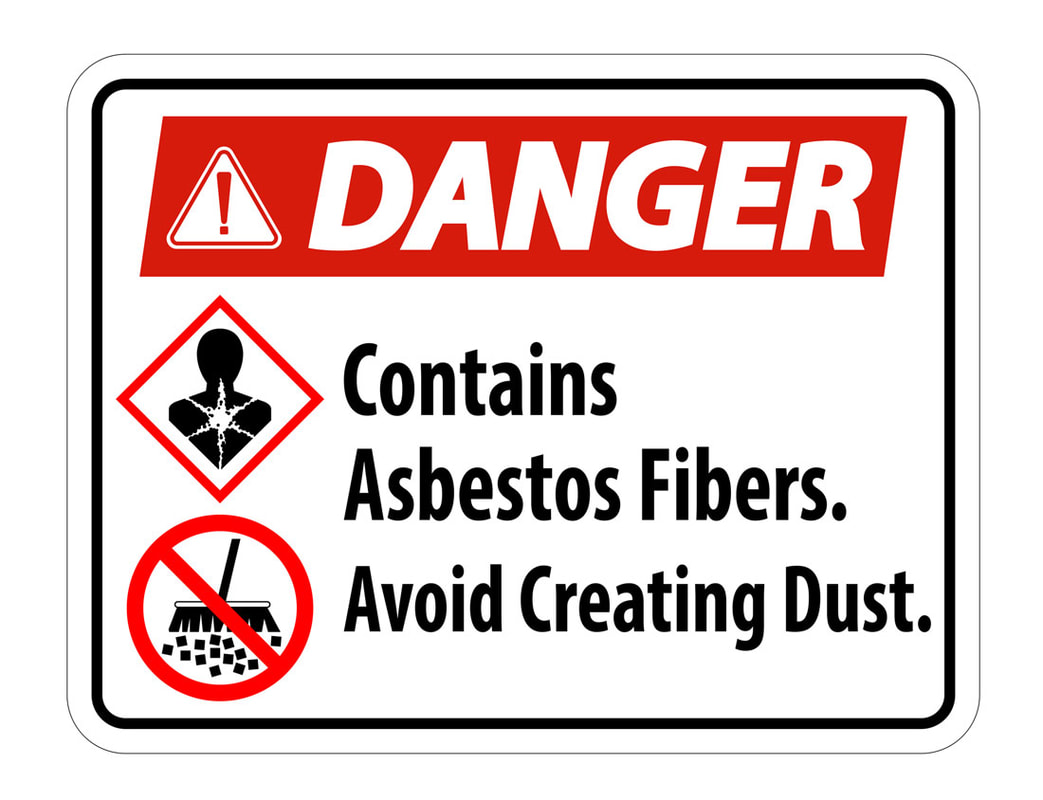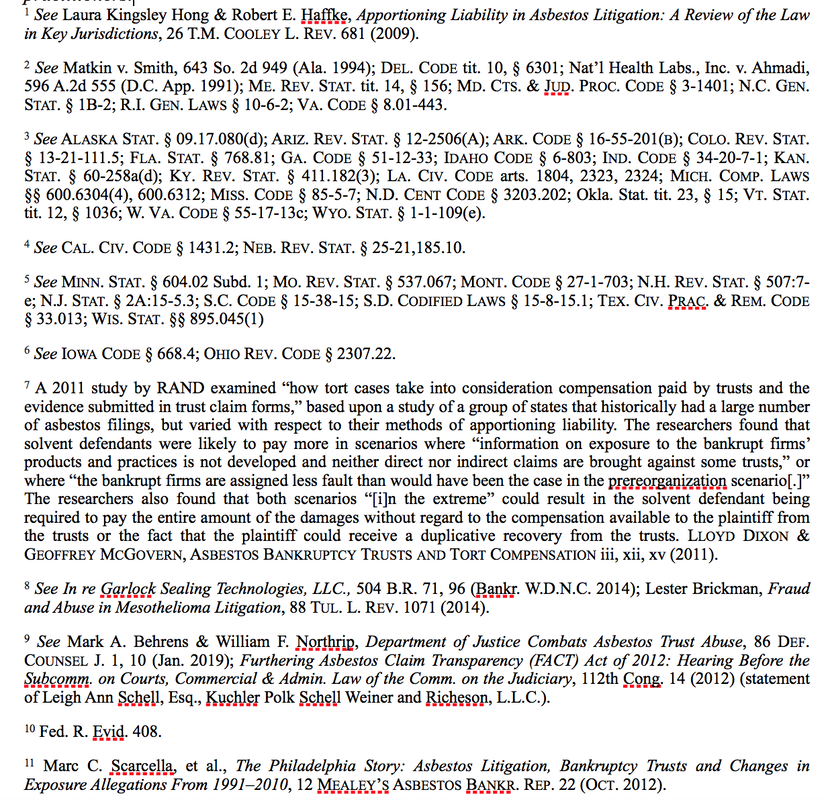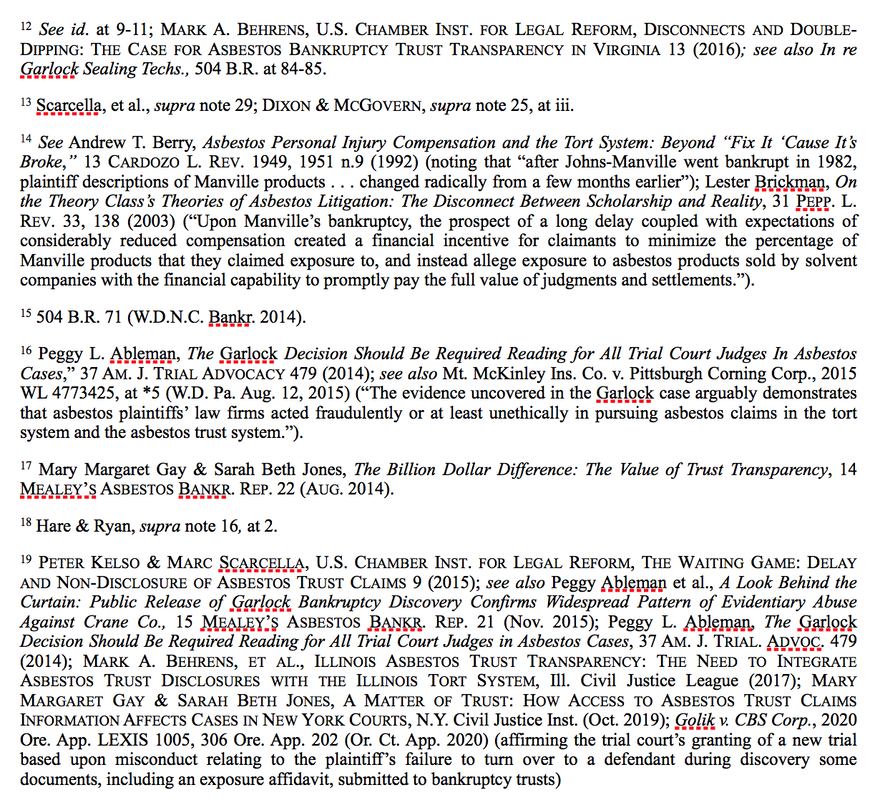The authors of this guest essay, Evelyn Fletcher Davis and William T. Wood, III are partners in the Atlanta office of Hawkins Parnell & Young, LLP, where their practices focus on asbestos litigation defense. This three-part guest article examines the evolution of the bankruptcy trust system (Part I), how control over the trust system by plaintiffs’ counsel has resulted in unfair allocations of responsibility, double recoveries and excessive costs (Part II), and offers practical advice to defense counsel to fix the disconnect between the tort and trust systems (Part III).
States have different mechanisms for apportioning liability when more than one party is responsible for causing injury. A few states have joint liability, which means that plaintiffs can collect their full damages from any responsible party, who can then seek contribution from other responsible parties. In other states liability is several, meaning that a defendant can only be held liable for that portion of the damages for which it is responsible. Other states apply joint liability in some situations and not others, such as for economic damages but not noneconomic damages, or if the defendant’s level of fault is above a certain threshold (e.g., above 50% at fault.). Some states apply a combination of both approaches. Other variations exist.
In order for any apportionment method to work fairly, a defendant needs to be able to develop a complete factual record of causation and responsibility. Consequently, it is imperative for a solvent asbestos defendant to be able to require the plaintiff to provide accurate and complete information about all the bankruptcy trust claims the plaintiff has filed or is eligible to file.
In a world where accurate and complete disclosures are made, bankruptcy trust claim information could be used to facilitate the resolution of tort claims in a timely and cost efficient manner. Asbestos litigation, for the most part, has been the opposite of such a world. Plaintiffs and their attorneys have acted in the ways described below to conceal their exposures to the products of the trust entities from defendants in the tort system, and thereby to foster a system rife with unfair allocations of responsibility, double recoveries and excessive costs.
A. Lack of transparency: From Concealment to Misrepresentation
One unintended and particularly pernicious impact of the creation of bankruptcy trusts is to cloak those claims in secrecy. Trust distribution procedures (“TDPs”) typically provide that claimants’ trust claim submissions are confidential settlement communications that cannot be disclosed except pursuant to a subpoena issued by the bankruptcy court presiding over the case. Thereafter, when solvent defendants in asbestos cases seek discovery of the submissions, they are met with objections under rules of evidence that typically prohibit communications and other information relating to compromise offers and negotiations from being admitted to “prove or disprove the validity or amount of a disputed claim[.]” In most states, a claim filed with a bankruptcy trust is not an offer to compromise since the plaintiffs’ sole legal remedy for their claims against bankrupt defendants is to submit their claims to the administrative processes of the bankruptcy trusts. Plaintiffs do not submit their claims to the trusts as an alternative to existing legal rights to file suits against the bankrupt defendants. They have no choice but to submit their claims to the trusts’ administrative processes and to follow the trusts’ procedures for pursing their claims.
B. “Strategic” Timing of Filing Claims
Another common feature of asbestos trusts is to permit claimants to delay filing trust claims until several years after asbestos related disease has been diagnosed, because “most asbestos trusts have a three year statute of limitations from diagnosis to trust claim filing that allows a window for tort recovery prior to trust claim filing.” Thus, claimants and their attorneys are empowered to file suit against solvent defendants to obtain such recoveries; and, when asked in discovery in those lawsuits to disclose trust claims, to respond that there are none to disclose. Alternatively, claimants may file and then defer trust claims, during which time the statute of limitations is tolled. Either way, after obtaining recovery by judgment or settlement against solvent defendants, claimants can proceed to recover on claims with trusts—often multiple trusts. This conduct occurs regularly and is well-documented, such as in studies of Philadelphia and Newport News, Virginia.
C. Changing Filing Patterns Caused By Asbestos Bankruptcies
The Philadelphia study and another conducted by RAND in 2015 demonstrate that, after an asbestos manufacturer files bankruptcy, the number of lawsuits wherein its products are identified by plaintiffs as sources of their asbestos exposures declines markedly from what the number was before the bankruptcy.As the Philadelphia study notes, the explanation for the findings is inherent in the “dual compensation system” that asbestos bankruptcy trusts have created.
Thus, concealing evidence regarding the bankrupt entities goes hand in hand with other tactics used to prevent defendants—and consequently, factfinders—from learning the truth about high dose asbestos exposures those plaintiffs received from the products of trust entities.
III. The Garlock Bankruptcy: A Game Changer
The event that forced authorities to finally confront the reality of abusive asbestos trust claim practices was a 2014 decision by U.S. Bankruptcy Judge George Hodges in In re Garlock Sealing Technologies, LLC. Garlock has been described as “a stunning exposé of the breadth of the practice of withholding exposure evidence concerning the products of bankrupt entities.” That exposé “clear[ed] the fog and document[ed] what appear[ed] to be a pattern of self-dealing and double-dipping in both the civil tort system and bankruptcy trust resources for recovery by some asbestos plaintiffs’ firms,” causing “courts, commentators, and other interested parties” across the country to take note.
IV. The Abusive Practices Revealed in Garlock Are Systemic and Ongoing
The evidence on which the Garlock decision was based, though under seal at the time the decision was issued, was subsequently made public. Statistical studies of the thousands of cases the record encompassed revealed that the “systemic practice” of withholding exposure evidence “was not isolated to Garlock and likely prejudiced any defendant who settled or paid a judgment in an asbestos case when trust exposure evidence was concealed.”
Indeed, the informational brief accompanying Bestwall LLC’s 2017 bankruptcy filing recounts a history much like Garlock’s. Bestwall, an affiliate of Georgia-Pacific, LLC, described instances where “asbestos plaintiffs, at a minimum, inconsistently and selectively disclosed exposure evidence to support or strengthen their cases against non-bankrupt companies.”
The recent bankruptcy filings also highlight another “systemic practice” of asbestos plaintiff attorneys which, while distinct from the issues regarding the bankruptcy trusts, likewise operates to drain resources from productive businesses and threatens to drive more of them into bankruptcy: the naming of scores of asbestos defendants by some plaintiff attorneys without proof that their clients were exposed to asbestos connected to those companies.
Summary of Part II and Preview of Part III:
The pattern of abuse highlighted in the Garlock decision continues today. The tactics employed by claimants and their attorneys, including failing to disclose bankruptcy trust claims and delaying the filing of trust claims, has hindered juries from properly allocating fault among defendants and bankrupt entities, resulting in double recoveries. Part III looks at recent legislative and judicial efforts to rectify these ongoing problems and offers advice to practitioners.





 RSS Feed
RSS Feed